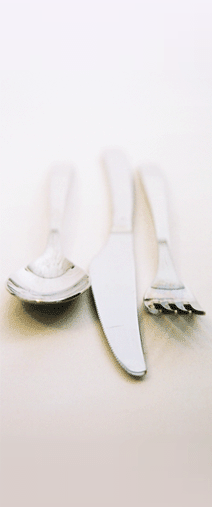Helping to organise a “Friggers” exhibition in Waterford in 2003 was a project I was proud to have been associated with, and one I enjoyed immensely.
I was at that stage a fairly novice member of the Glass Society so my involvement was just a question of being in the right place at the right time.
I was also asked to give the opening introduction speech and, as I still have a copy of this, and it is self explanatory, I will quote most of it and illustrate where appropiate with some photos which my daughter Caitriona took of the exhibits.
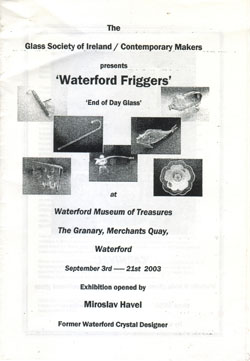
This is the original Programme
As you can see we were fortunate to have Miroslav Havel, the father of Waterford Crystal, to open the exhibition.
Waterford Friggers Exhibition
(My introductory speech)
When Una Parsons told me, about six months ago, that the glass society of Ireland-on a suggestion by Roisin de Buitleir- were going to put on an exhibition of “Friggers” in the Waterford Museum of Treasures, I must confess to feeling some surprise that -even in this permissive age-such people were going to be celebrated.
The Oxford dictionary soon however put me right.The second given meaning of Friggers are those pieces of “end of day” glass made in their own time by workers using up the left over molten glass from the furnaces or the scraps or off cuts of other pieces. There is a long tradition of making friggers and they were made in the 18th and 19th centuries in nearly every glassmaking district. Certain objects seem to have been universally popular as friggers,possibly because the factory product gave a jumping off ground for their production. In Waterford the more popular pieces included fish, swans,walking sticks, baskets and many more.
Three of us then got together to organise this exhibition of Friggers.The indefatigable Una Parsons was to be our chief whip. Eamonn Hartley,who had just recently retired as an engraver in Waterford Crystal to set up an independent business on his own,provided many of his own friggers for the exhibition as well as being an invaluable lifeline to the frigger makers of the crystal factory.My own contributions were to be a fish,which my wife, a teacher, had been given by a pupil one Christmas,
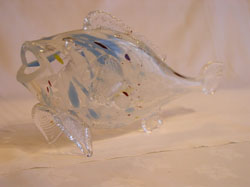
a milk bottle with a cut base which had been delivered with milk in one morning
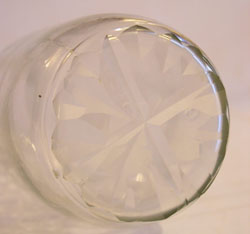
These were practice pieces, young apprentices would try their hand at cutting on milk bottles, much to the annoyance of Snowcream, the local dairy!
and a mysterious glass rod,
purchased in a junk shop in Virginia County Cavan last June.
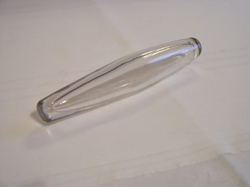
( from a darner or a slicker stone?)
since revealed to be a Confiseurs Rolling Pin by the good auspices of the Ulster Museum, and therefore not a frigger at all!
We decided that to gather the Friggers we should have an “Antiques Roadshow” event and invite people to show us their friggers and to select some for exhibition. Our main job then was to crank the publicity machine into action to make sure we got a good attendance at the roadshow.In this of course we knew we were going to be helped enormously by the ambiguity of the word frigger.We were also helped, if inadvertently, by the compilers of the programme for the fringe of the Waterford Light Opera Festival. They included us as an exhibition “organised by the Waterford Friggers” and in a moment gave our little group a name!
I introduced the “Frigger” on our local radio station here in Waterford in the begining of the August. I just asked “What is a frigger” and offered a prize for the correct answer, the only clue was “most of you will have one at home”. The reaction was amazing!It appears that a lot of Waterford people have the most astounding things at home, the best answer was unfortunately unprintible,
(This was by a lady who phoned me and said she”thought it was something of a sexual nature”)
but quite a few got it correct.
This started the ball rolling, we got a lot of coverage from the local press and posted the town with bills saying “Have you got a Frigger in your house”,but we still faced our “Frigger Roadshow” on August 26th in Dooleys Hotel with much trepidation. Were we going to get absolutely no-one in? Were we just going to get hundreds of walking sticks, fish and swans? (Waterford artist Ben Hennessy tells how, on the way home from school, he and his friends used to compete to see who could spot the most swans/fish/walking sticks in the windows of Ballytruckle)
We of course had no cause for concern. Waterford excelled itself and the quality of pieces which which were brought in on that day was a revelation.
People arrived with suitcases of masterpieces which they shyly showed to us. I use the word masterpiece very deliberately, as this is exactly what they are. Products, in some cases, of many years work by skilled master craftsmen whose great creativity was perhaps not sufficiently challanged by their work in the factory, the variety and ingenuity of the way these people had put together their peices was breathtaking.
We were told how the fish were an extension of a vase form, how one frigger started off as a fish, got pot bellied and became a grecian blue and white jug, how an off cut from the wings of an American eagle became a delightful pot-pourri bowl with a humming bird perched on its rim.
We were shown a piece of cullet whose naturally occurring bubbles gave the idea for an engraving of a school of dolphins, and another piece of glass when the bubbles became the holes in a block of cheese)
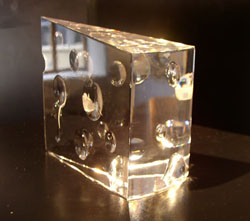
This by artist Greg Sullivan was awarded 2nd place by Mary Boydell
(in this case made even more interesting by the engraving of a mouse in one of the holes)
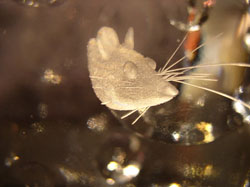
A heart love token (made from the stem and base of a drinking glass)was presented by a lady who wasn’t prepared to tell us anything of it’s history
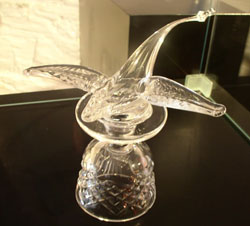
This beautiful “Swan In Flight” by Henry Moloney was , justifiably given 1st Prize
and a wonderful prism into which had been cleverly engraved a hot air balloon,
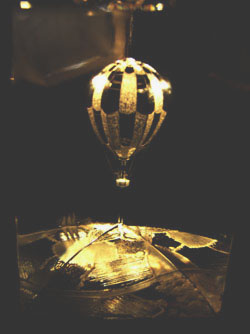
One of several great pieces by Eamonn Hartley
And this was only the recent stuff!
Miroslav Havel himself was kind enough to send us some early Czech friggers and some examples of pre- production glasses,including an elegant piece of soda glass called Carnival,which was cut and painted with coloured glass clowns ,made before the factory had even started.
Vivienne Keane brought in a charming and delicately blushing pink pig which came from the 40s or 50s
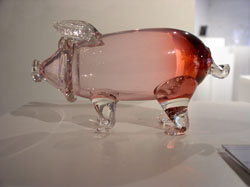
Given 3rd Prize by Mary, this afterwards made it to the cover of Gloine, the glass society journal
but our one possibility of a frigger from the first incarnation of “Waterford Glass” came in the shape of a walking stick. This was brought all the way from Wicklow by a gentleman who’s grandmother had come from Mullinavat and whose walking stick’s pale green tint revealed it as bottle glass and to definitely pre date modern Waterford Crystal.
These levels of recognition and skills in dating could only have come from one person. We were privileged to have Mary Boydell as our judge for the day.As well as judging the friggers to go to the exhibition, and the prizes for the most interesting, Mary had to act as an unofficial, one woman Antiques Roadshow of Glass as word got around Waterford that she was in town and people started arriving with all sorts of glass for her to identify. This she did with great tact and erudition and I confess that when I got her to my restaurant that night I likewise kept proffering pieces for identification.
We had got ourselves some T shirts with the logo; “I am a Waterford Frigger”printed on them and in an official ceremony at the end of the roadshow we elected Mary to our society and presented her with the T shirt which she promised to wear at her next cocktail party.
Perhaps the whole day can best be encapsulated by our winner of the most interesting prize for a frigger:
Henry Moloney had to be persuaded to produce his “Swan in Flight” from his bag. He said that he was just “fooling around with some molten glass on a broken off port glass”, he tried to do a swan and “the neck just stretched out, it looked nice so I decided to leave it”.
It’s a beautiful piece which captures the take off of the flight of a swan in an most impressionistic way.
I feel fortunate to have been there when these pieces were shown for the first time.In fact we discovered it was the very first exhibition of Friggers in Ireland.
The next is going to be even more interesting.
So that was my introduction.
Before I gave that, one of my very first pieces of public speaking and I was petrified, I felt it only fair to introduce my self.
I said that I hoped that the people of Waterford wouldn’t be offended by a “Blow In “ of a mere 24 years residence introducing them to their own craft.
The best moment of the day was when I was leaving the exhibition an old retired blower from “The Glass” caught my hand to thank me.
“You are no blow in Martin” he said “Sure you are one of our own”
One one my nicest compliments ever
2 comments
